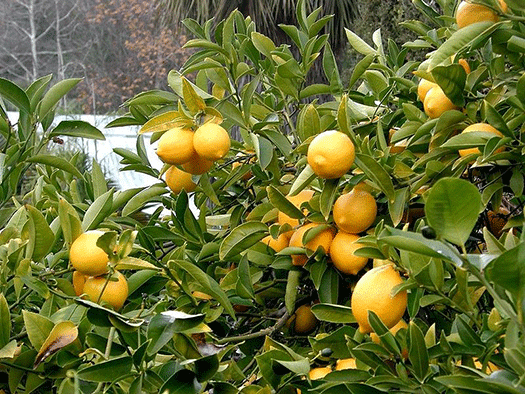Touch-Up Pruning for Lemon Tree Health
Gardener’s Notebook

Permaculture expert Joshua Burman Thayer advises light pruning this month
to help citrus trees thrive. Photo: Allen Timothy Chang
Many Bay Area property owners enjoy great yields from their citrus trees, but most are unclear about when and how to prune them. The common wisdom is to prune in winter, but citruses, which have a sub-tropical heritage, are best pruned when there is no threat of frost or rain. Light touch-up pruning of those trees contributes to optimal health, and June is a good time to do it. Here’s how.
Prune out dead wood: Dead branches on lemon trees often look like grey pencils. After you have taken these out, look toward the center of the tree. Trees that are too dense inside can succumb to mites, scale, whitefly, thrips, and mold. By pruning out and reducing density of branches, you allow light and air to penetrate and encourage more fruit to set inside the tree.
Prune out non-fruiting, non-flowering branches: Your tree can be happily flowering and fruiting throughout much of the year. By keeping an eye on the locations of fruit and flowers week by week, you can find small branches that have neither. This is a slow and deliberate process, but gradually, you will find that one branch in 20 is just a small shoot of leaves with neither fruiting nor flowering parts. By taking out these less vigorous branches, you are helping the tree support the branches where it is putting its fruiting energy.
Only prune pencil-thick branches: Pruning away thicker branches (broom-handle thick, for example) will often send the tree into defense mode and cause it to send out a big, straight, ancestral shoot, which is not fruiting but is full of spikes.
No citrus trees? Residents in the eastern parts of Contra Costa and Alameda counties, where winters are colder, might try growing kumquat.
Have only a small growing space? Try Dwarf Bearss Lime and Dwarf Meyer Improved Lemon.
Have mites, scale, whitefly, or thrips appearing on your citrus even after pruning? Try Joshua’s Foliar Spray. It’s 10 drops of peppermint essential oil in a 750 ml spray bottle of water. Use it to spray down citrus once a week just before sundown. The aromatics and stickiness of the peppermint will deter the pests.
Permaculture designer and educator Joshua Burman Thayer is a regular contributor to Edible East Bay. In his monthly Gardener’s Notebook feature in Edible East Bay’s free e-newsletter, he offers lots more advice on how to implement gardening ideas like this one. Sign up for the newsletter here. Josh has also written for Mother Earth News and Edible Silicon Valley. Find him and his work at nativesungardens.com, and follow him on Twitter at @nativesungarden.

